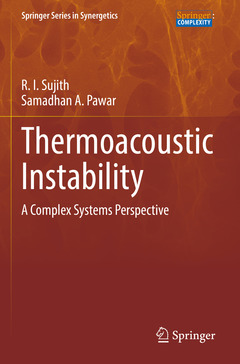Description
Thermoacoustic Instability, 1st ed. 2021
A Complex Systems Perspective
Springer Series in Synergetics Series
Authors: Sujith R. I., Pawar Samadhan A.
Language: English
Subjects for Thermoacoustic Instability:
168.79 €
In Print (Delivery period: 15 days).
Add to cartPublication date: 12-2022
467 p. · 15.5x23.5 cm · Paperback
168.79 €
In Print (Delivery period: 15 days).
Add to cartPublication date: 12-2021
467 p. · 15.5x23.5 cm · Hardback
Description
/li>Contents
/li>Biography
/li>Comment
/li>
This book systematically presents the consolidated findings of the phenomenon of self-organization observed during the onset of thermoacoustic instability using approaches from dynamical systems and complex systems theory. Over the last decade, several complex dynamical states beyond limit cycle oscillations such as quasiperiodicity, frequency-locking, period-n, chaos, strange non-chaos, and intermittency have been discovered in thermoacoustic systems operated in laminar and turbulent flow regimes. During the onset of thermoacoustic instability in turbulent systems, an ordered acoustic field and large coherent vortices emerge from the background of turbulent combustion. This emergence of order from disorder in both temporal and spatiotemporal dynamics is explored in the contexts of synchronization, pattern formation, collective interaction, multifractality, and complex networks.
For the past six decades, the spontaneous emergence of large amplitude, self-sustained, tonal oscillations in confined combustion systems, characterized as thermoacoustic instability, has remained one of the most challenging areas of research. The presence of such instabilities continues to hinder the development and deployment of high-performance combustion systems used in power generation and propulsion applications. Even with the advent of sophisticated measurement techniques to aid experimental investigations and vast improvements in computational power necessary to capture flow physics in high fidelity simulations, conventional reductionist approaches have not succeeded in explaining the plethora of dynamical behaviors and the associated complexities that arise in practical combustion systems. As a result, models and theories based on such approaches are limited in their application to mitigate or evade thermoacoustic instabilities, which continue to be among the biggest concerns for engine manufacturers today. This book helps to overcome these limitations by providing appropriate methodologies to deal with nonlinear thermoacoustic oscillations, and by developing control strategies that can mitigate and forewarn thermoacoustic instabilities.
The book is also beneficial to scientists and engineers studying the occurrence of several other instabilities, such as flow-induced vibrations, compressor surge, aeroacoustics and aeroelastic instabilities in diverse fluid-mechanical environments, to graduate students who intend to apply dynamical systems and complex systems approach to their areas of research, and to physicists who look for experimental applications of their theoretical findings on nonlinear and complex systems.
Prof. R. I. Sujith received his Ph. D. adorned with the “top graduate student in the college of engineering” award from Georgia Institute of Technology in 1994 under the supervision of Prof. Ben T Zinn. He is currently the D. Srinivasan Chair Professor at the Department of Aerospace Engineering at the Indian Institute of Technology Madras. He is a recipient of the prestigious Alexander von Humboldt Fellowship and the Hans Fischer Senior Fellowship of the Institute for Advanced Study (IAS) at the Technical University of Munich. Prof. Sujith was the founding Editor-in-Chief of the International Journal of Spray and Combustion Dynamics from 2009-2015, and is at present a member of the editorial advisory board of the interdisciplinary journal Chaos. He won the Young Engineer Award of the Indian National Academy of Engineering. He has also been awarded the Swarnajayanti Fellowship and the J. C. Bose Fellowship by the Department of Science and Technology India. He isa fellow of the Indian National Academy of Engineering and the Indian Academy of Sciences, and has been conferred the title of “TUM Ambassador” by the Technical University of Munich. Prof. Sujith currently works on the application of dynamical systems and complex systems theory to study and mitigate thermoacoustic instability.
Dr. Samadhan A. Pawar received his Ph. D. from the Indian Institute of Technology Madras under the supervision of Prof. R. I. Sujith and Prof. Mahesh V. Panchagnula. He was conferred the ‘Institute Research Award’ from IIT Madras (2018) in recognition of his doctoral research work on the application of synchronization theory to thermoacoustic systems. Dr. Pawar has also been awarded the ‘Young Scientist Award 2021’ by the International Society for Energy, Environment and Sustainability (ISEES) in view of his impressive contributions to the research field at a very young age. Currently, he is a Postdoctoral Fellow in Prof. Sujith’s lab at IIT Madras.H




